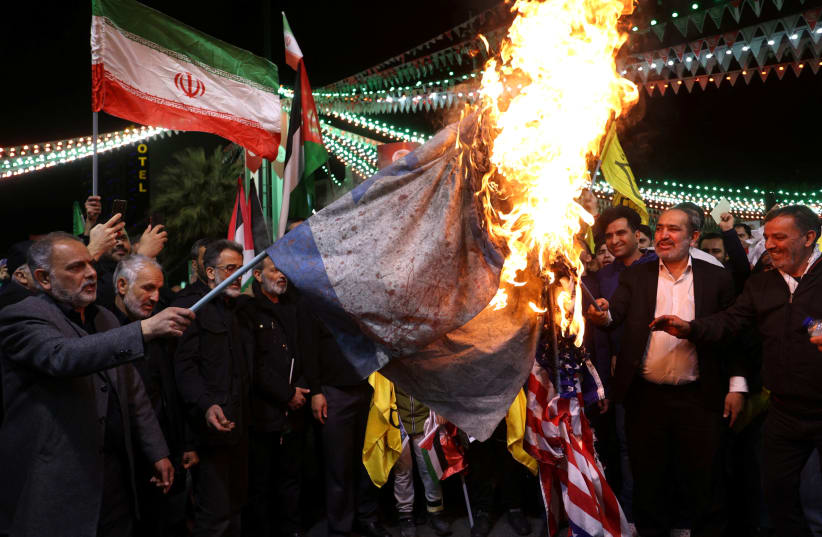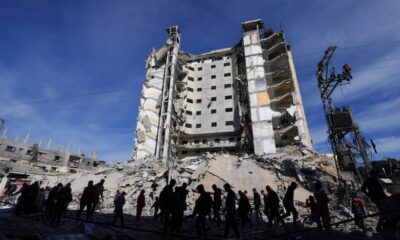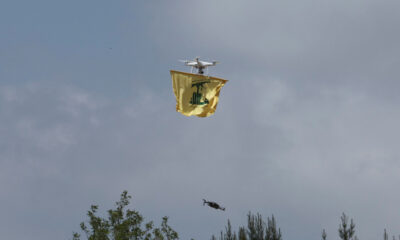Article
Iran has ten ways to attack Israel; which one will it choose? – Analysis

Iran’s vowed punishment of Israel might manifest either through proxies or direct means, including ballistic missiles and drones.
Iran has vowed to “punish” Israel for an airstrike in Damascus on April 1, which Tehran blamed on Israel. Over the last week and a half, Iranian leaders have made repeated threats against Israel. These threats have led to heightened tensions in the region.
Iran has a track record of threatening Israel and another track record of using its proxies to threaten and attack Israel. What follows is a list of different attacks Iran could carry out based on how Iran has behaved.
A ballistic missile strike from Iran
Iran has a large arsenal of ballistic missiles of varying types and ranges. Some are solid-fueled, and some are liquid-fueled, which means some can be rushed out to be fired relatively quickly, while others take time to prepare and position. Iran has used ballistic missiles frequently in the past.
Iran used ballistic missiles to target the Al-Asad base in Iraq on January 8, 2020, in retaliation for the US killing IRGC Quds Force head Qasem Soleimani. Iran launched up to 22 missiles, targeting both the Asad base – where US troops are based in western Iraq – and also targeting the Kurdistan autonomous region, which hosts US forces. The missiles were launched from several locations in Iran, and 11 of them struck Asad’s base. Iran informed the Iraqis just before they launched the rockets.
The missiles were launched beginning at 1:20 am, and the attack continued for several hours. It is believed Iran used the Fateh 313 and Qiam ballistic missiles in the attack. They contained warheads of more than 450kg.
A ballistic missile strike from Iraq
Iran has been moving missiles and drones to Iraq for several years. Beginning around 2018, reports emerged in various media that Iran was basing rockets in Iraq. It was not clear after 2019 what became of these missiles because the reports about them stopped occurring.
However, it is clear that during the period 2018-2019, the Iranian-backed militias in Iraq, with which Iran works closely, had extended their control into Anbar province and defeated ISIS there. Iran then moved to create a base called Imam Ali in Syria near Albukamal on the border with Iraq. Iran uses this area to smuggle weapons via Syria to Hezbollah.
Anbar province in Iraq is the closest part of Iraq to Israel. It is also where Saddam Hussein placed Scud missiles in the 1991 war, which targeted Israel. A lot of effort was spent at the time by the US-led coalition seeking to “hunt” down the elusive Scud launchers. Iran may seek to place long-range missiles in Iraq and recreate a Saddam scenario.
New long-range ballistic missiles Iran recently tested
In January 2024, Iran carried out missile attacks on Pakistan and Syria. It claimed to be targeting terrorist groups. Iran used this occasion to test the precision of its missiles. In Syria, it used long-range and relatively new Kheibar Shekan ballistic missiles.
The attack was a “message” for the US and Israel, according to Iranian media. The rocket had been unveiled in 2022. Iran claims it has a range of 1,450 km. and is supposed to have high-speed and precision-strike capabilities, which makes it a dangerous strategic weapon.
A combination drone and cruise missile attack
In September 2019, Iran carried out an attack using drones and cruise missiles targeting Saudi Arabia’s Abqaiq facility. The attacks were carried out from Iran. Iran used a mixture of drones and cruise missiles in the attack. It was initially believed around a dozen cruise missiles were involved and two dozen drones.
A total of 18 drones and seven missiles were used, the Saudis said. The attack occurred at night. The drones had a delta-wing configuration, which made them similar to the Iranian Shahed 136 drones, which are now standard. The full details of the types of drones used were not precise.
Iran was able to avoid Saudi Arabia’s air defenses and radar by planning a complex mission and using an attack vector that went through an area that was either undefended or where the systems in place were not being used correctly. The attack caused damage but did not kill anyone. It was seen as a symbolic curtain raiser on Iran’s capabilities.
Iraqi militias using drones or missiles
Iranian-backed militias in Iraq have been increasing their threats to Israel in recent weeks. The Islamic Resistance in Iraq, which is an Iranian proxy group, frequently claims to have targeted Israel. It has claimed to target Eilat, for instance. A drone struck a hangar in Iraq in the early hours of April 1. Another drone was recently intercepted by the C-Dome system aboard a Sa’ar 6 Israeli ship.
Iran could mobilize Iraqi militias to carry out attacks on Israel. This would give Iran plausible deniability in the attacks. Iran has used these militias in the past to target Israel with drones in May 2021. The groups in Iraq have also targeted US forces and killed three Americans in Jordan in January 2024 using a drone attack.
Iranian-backed terrorists in Syria
Iran has a plethora of Iranian-backed groups in Syria. These include Hezbollah operatives who work near the Golan as part of Hezbollah’s “Golan File” unit. Hezbollah sought to threaten Israel from an area near the Golan using a “killer drone” unit in the fall of 2019. Israel struck the Hezbollah cell at the time. In recent months, Hezbollah has also sought to use Syrian army facilities near the Golan.
Iran also works with the Fetemiyoun, a group of Afghan Shi’ites it recruited, and it has used the group to patrol areas near the Euphrates River in Syria. The Iranian IRGC runs the group. Iran could transfer weapons to this militia or other militias and operationalize them for attacks on Israel. Iran has used these types of groups to carry out dozens of attacks on US forces in Syria in the last several years.
An Iranian-backed coalition of Houthis, Hezbollah, and other groups
Iran could attempt to carry out a multi-front attack on Israel using groups it has already pushed to attack Israel since October 7. For instance, the Houthis in Yemen have long-range missiles and drones that they have already used numerous times to threaten Israel. The Houthi threat returns to at least 2020 when they acquired the Iranian Shahed 136. This is the same type of drone that Iran has exported to Russia.
It has a range of around 2,000km. Iran has systematically increased the range of its various types of drones. It prefers kamikaze drones because of their low cost and because they can be pre-programmed to fly waypoints, which makes them difficult to detect. They are not very large, giving some of them a low radar cross signature.
Iran could seek to push several of its partners and proxies to carry out a multi-front attack. Iran has already attempted this during the current war on Israel. For instance, Iraqi militias have targeted Eilat, and also in November, an Iranian-backed group in Syria targeted Eilat.
Hezbollah has fired thousands of missiles at Israel. The Houthis have launched cruise missiles, drones, and also ballistic missiles. Iran seeks to ring Israel with this “fire,” and it has already successfully mobilized most of the components involved. Israeli officials have described this as a multi-front threat that involves up to seven fronts.
An attack on Israel in other countries
In the last decades, Iran has threatened Israelis, Israeli embassies, and Israel-linked things in other countries. For instance, a 2012 bombing in Burgas, Bulgaria, was linked to Hezbollah. Iran has been behind plots in India, Georgia, Azerbaijan, Thailand, and many other countries. Iran works through proxies such as Hezbollah and also has a long track record of these types of threats. Iran may believe that targeting an Israeli embassy abroad or Israelis abroad is an easier way to strike at Israel.
An attack on the Kurdistan region in Iraq
Iran has frequently targeted the Kurdistan autonomous region in Iraq over the last two years, claiming to be targeting it because of links to Israel. It has targeted the homes of Kurdish businessmen, killing one and destroying the house of another. Iran frequently uses missiles and drones in these attacks.
Pushing Hezbollah into a war
Iran has pushed Hezbollah to attack Israel numerous times since the Hamas attack on October 7. Hezbollah has already fired thousands of missiles at Israel. Iran could seek to use Hezbollah to escalate attacks on Israel. This would be the war in the north that Israel has been warning about for months and which Israel has prepared for. Iran has sought to increase the capabilities of Hezbollah over the last years, and it has weighed when to use Hezbollah to escalate.


















